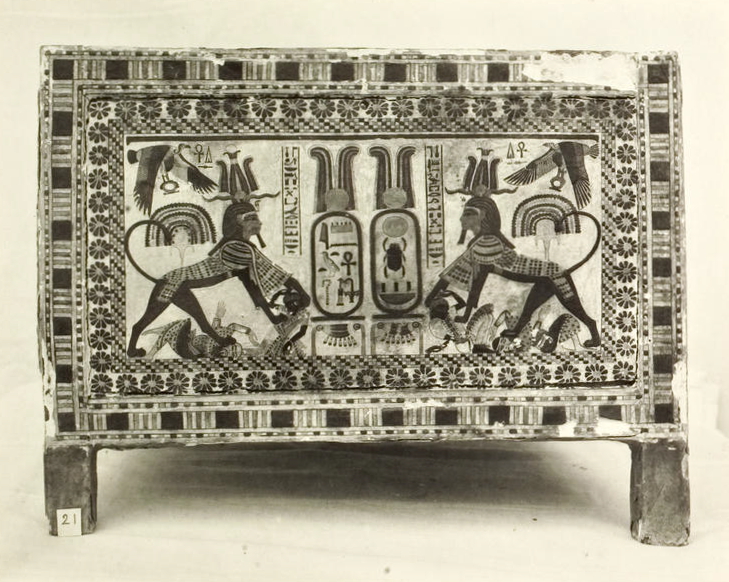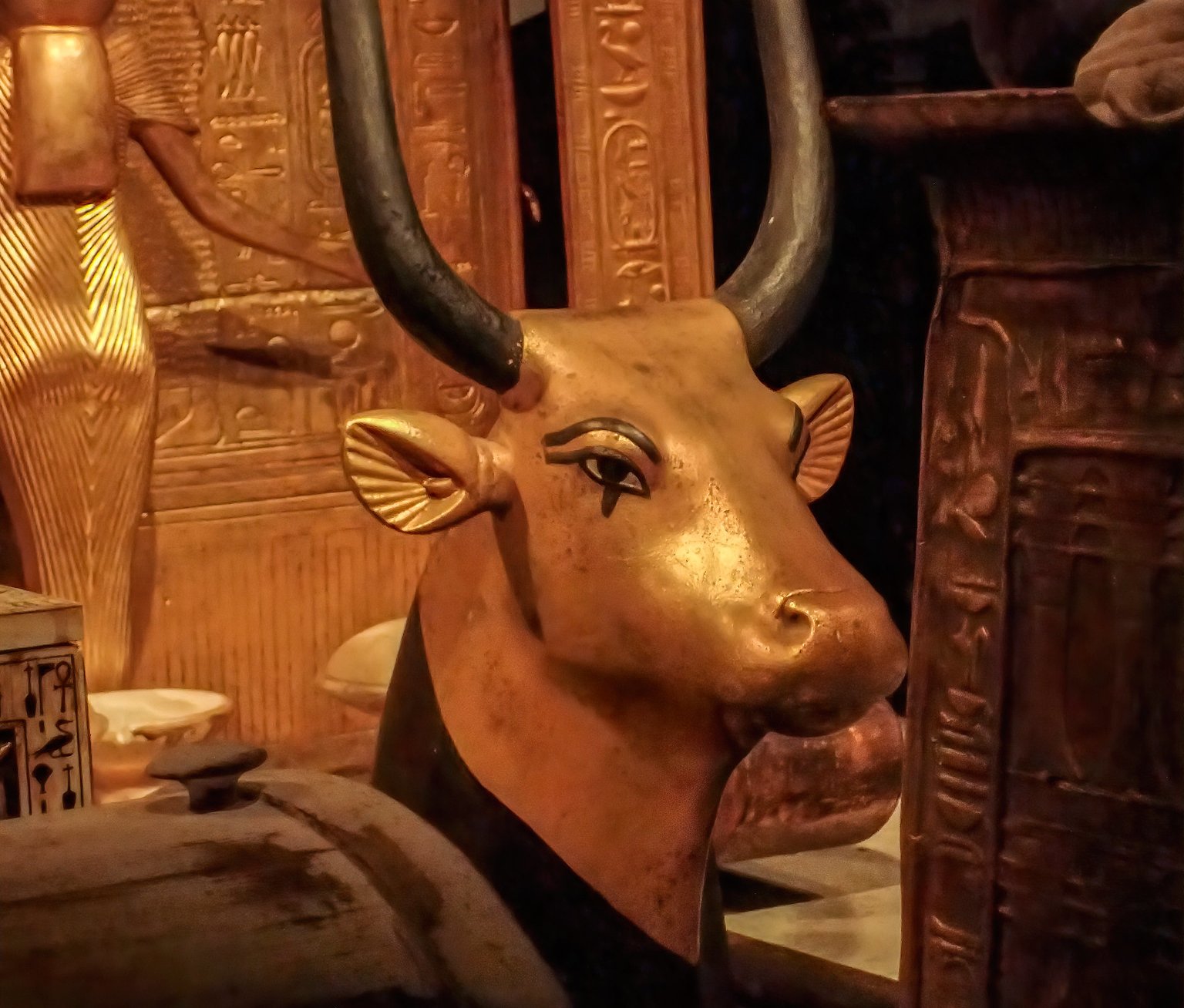Ancient Egypt: The Land Of King Tut
Ancient Egypt, one of the world's earliest civilizations, flourished along the Nile River for 3,000 years. This was the land of the pharaohs, and one of them in particular remains a point of fascination for people all over the world: King Tutankhamun, commonly referred to as King Tut.
The discovery of the young pharaoh's tomb showed us what a royal Egyptian burial was really like—and sparked rumors of a deadly ancient curse.

Ancient Egypt: The Pharaohs
The pharaohs of ancient Egypt were not just political leaders but divine rulers as well. They held sway over both the spiritual and political realms.
 Kenneth C. Zirkel, CC0, Wikimedia Commons
Kenneth C. Zirkel, CC0, Wikimedia Commons
Ancient Egypt: The Pharaoh Was More Than Just A Leader
The ancient Egyptians believed the pharaoh was a god incarnate, walking among them. Preparing for the pharaoh for a good afterlife was crucial because he would ensure the continuation of divine rule and maintain cosmic order.
 Mary Harrsch, CC BY-SA 4.0, Wikimedia Commons
Mary Harrsch, CC BY-SA 4.0, Wikimedia Commons
Ancient Egypt: The Pharaoh's Tomb
Initially, the ancient Egyptians built monumental pyramids as burial sites for their pharaohs. These massive tombs, such as the pyramids, were filled with treasures and provisions for the afterlife.
 Djehouty, CC BY-SA 4.0, Wikimedia Commons
Djehouty, CC BY-SA 4.0, Wikimedia Commons
Ancient Egypt: Choosing The Valley Of The Kings
Pharaohs began building their tombs in the Valley of the Kings in 1539 BCE. They hoped the valley's natural rock formations would safeguard the tombs from looting and provide greater security and secrecy.
 Francesco Gasparetti, CC BY 2.0, Wikimedia Commons
Francesco Gasparetti, CC BY 2.0, Wikimedia Commons
Who Is King Tutankhamun?
King Tutankhamun was a young pharaoh of the 18th Dynasty. He ascended to the throne around 1332 BCE at the age of nine. Because he was so young, King Tut likely ruled with the assistance of advisors and military generals.
 Mark Fischer, CC BY-SA 2.0, Wikimedia Commons
Mark Fischer, CC BY-SA 2.0, Wikimedia Commons
King Tut's Egypt: Conflict With The Neighbors
Tutankhamun ruled Egypt during a time of conflict, when battles over land raged between Egypt and the neighboring kingdom of Nubia.
 Daderot, CC0, Wikimedia Commons
Daderot, CC0, Wikimedia Commons
King Tut's Egypt: Military Campaigns
Tut's mortuary temple at Thebes recorded his battles with Nubians and Asiatics. His military reign was among several other undefeated reigns in ancient Egypt's history.
 Michael Barera, CC BY-SA 4.0, Wikimedia Commons
Michael Barera, CC BY-SA 4.0, Wikimedia Commons
King Tut's Egypt: Restoring The Old Religion
Tut's predecessor, his father, Akhenaten, adopted monotheism. Under Akhenaten, the people were no longer allowed to worship their many gods, including Amun, who they believed was the king of all the gods. They now had to worship the Aten.
 Diego Delso, CC BY-SA 4.0, Wikimedia Commons
Diego Delso, CC BY-SA 4.0, Wikimedia Commons

History's most fascinating stories and darkest secrets, delivered to your inbox daily.
King Tut's Egypt: Worshiping Amun
King Tut restored the images of the old gods, priests, and temples. This won him the respect of the people, as Amun's sacred shrines had been damaged or destroyed during his father's rule.
 Museo Egizio, CC0, Wikimedia Commons
Museo Egizio, CC0, Wikimedia Commons
King Tut's Egypt: Tut Changes His Name
Tutankhamun was initially named “Tutankhaten”. His father, King Akhenaten, had named Tut after the one god worshiped at that time, Aten.
 Harry Burton, Wikimedia Commons
Harry Burton, Wikimedia Commons
King Tut's Egypt: His Reign Is Cut Short
King Tut’s reign was relatively short, lasting only about 10 years. Tut ruled until his demise at approximately 18. Many theories exist as to why he perished at such a young age.
King Tut's Tomb: A Little Small For A Pharaoh
King Tut's tomb was relatively small compared to other royal tombs. Still, it contained many treasures, including his mummy, gold jewelry, statues, furniture, and clothing.
 Mark Fischer, CC BY-SA 2.0, Wikimedia Commons
Mark Fischer, CC BY-SA 2.0, Wikimedia Commons
King Tut's Tomb: Who Discovered It?
Tut’s tomb lay hidden until 1922, when British archaeologist Howard Carter found its entrance. But he did not make this discovery alone—he had help from a Lord.
 Exclusive to The Times, Wikimedia Commons
Exclusive to The Times, Wikimedia Commons
King Tut's Tomb: Howard Carter And Lord Carnarvon Meet
Howard Carter met Lord Carnarvon, an amateur archaeologist, in 1907. They began the search for Tutankhamun’s tomb after receiving permission to dig in the Valley of the Kings.
 Harry Burton, Wikimedia Commons
Harry Burton, Wikimedia Commons
Searching For King Tut's Tomb: The Work Begins
After World War I, Carter could do more work in the valley. Carnarvon and Carter believed that Tut was still in the Valley of the Kings, even though other archaeologists thought there was nothing left to find.
![Howard Carter, English Egyptologist [1874-1939] discovered the tomb of the previously unknown Tutankhamun in the Valley of the Kings](https://www.factinate.com/storage/app/media/historyexpose/2024/8/26/howardcarterengelseegyptoloog1874-1939ontdekteop4februari1922detombevandetotdansfa001006309.jpg) Unknown Author, Wikimedia Commons
Unknown Author, Wikimedia Commons
Searching For King Tut's Tomb: Just One More Chance
After 10 years without a discovery, Carter convinced Carnarvon to give him one last chance to find Tut's Tomb. It took another five years, but it was worth it!
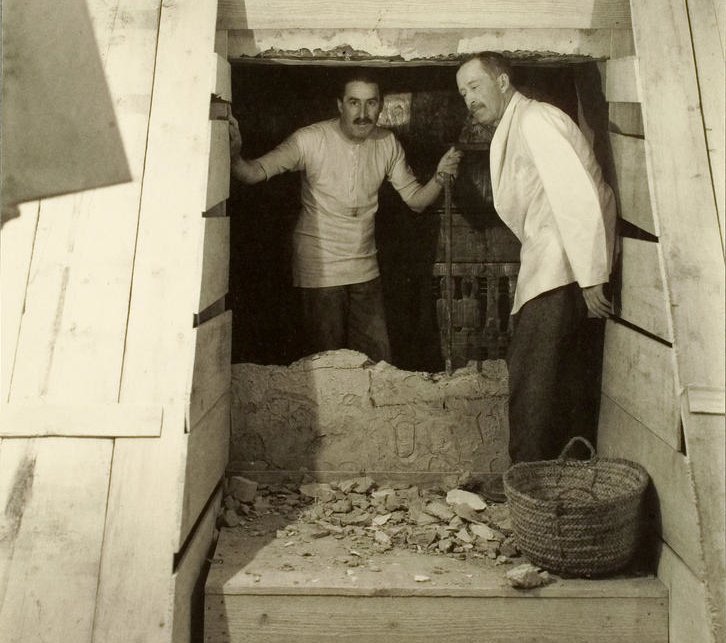 Harry Burton, Wikimedia Commons
Harry Burton, Wikimedia Commons
Searching For King Tut's Tomb: Steps In The Stone
Howard Carter and his workers discovered King Tut's tomb in the Valley of the Kings on November 4, 1922. An Egyptian boy hired by Carter to help his workers saw a step carved into the rock.
 Harry Burton, Wikimedia Commons
Harry Burton, Wikimedia Commons
Searching For King Tut's Tomb: Finally Found
That first step led to more. Then, Carter noticed a sealed door at the bottom of the steps. He sent a message to Lord Carnarvon to come quickly!
 Harry Burton, Wikimedia Commons
Harry Burton, Wikimedia Commons
Searching For King Tut's Tomb: Wonderful Things
When asked if he saw anything when he first peered into King Tut's tomb, Carter said, "Yes, wonderful things". But Carter was only looking into the antechamber—there was much more to discover!
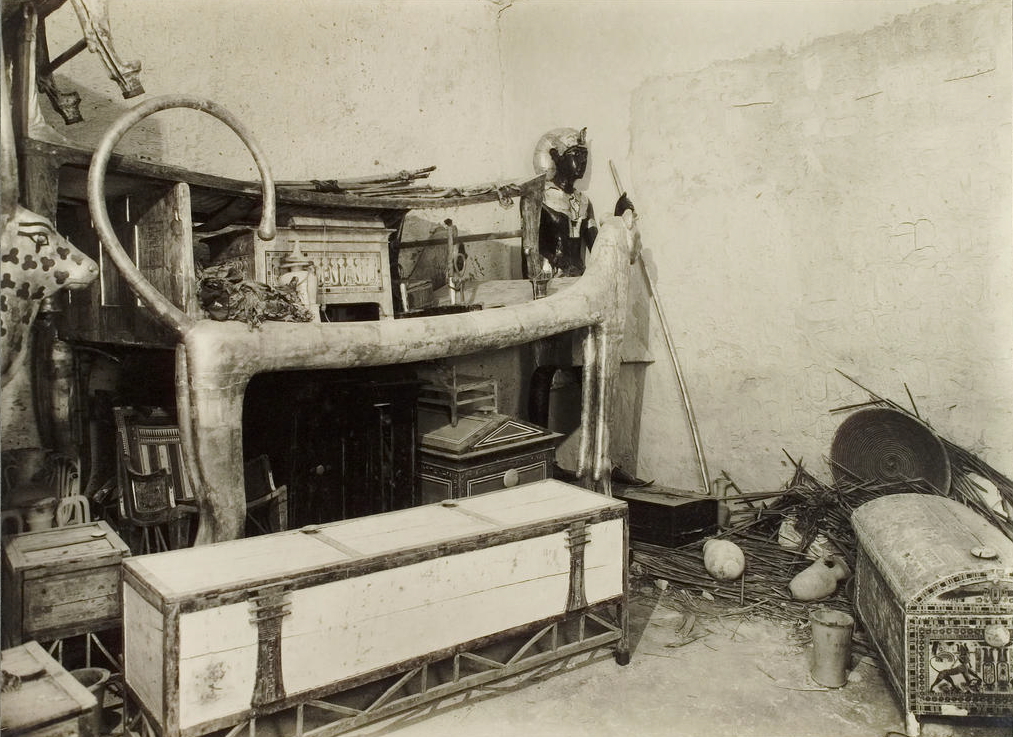 Harry Burton, Wikimedia Commons
Harry Burton, Wikimedia Commons
Inside King Tut's Tomb
On November 27, 1922, Carter and Carnarvon—accompanied by Carnarvon's daughter, Lady Evelyn Herbert—examined the antechamber and annexe of King Tut's tomb. Then, they discovered a sealed door leading to another chamber.
 Harry Burton, Wikimedia Commons
Harry Burton, Wikimedia Commons
Inside King Tut's Tomb: The Antechamber
The antechamber contained many astonishing artifacts, including chariots, furniture, and jewelry. Other notable items included a gilded wooden throne, a series of statues, and many beautifully decorated and intricately crafted keepsakes.
 Djehouty, CC BY-SA 4.0, Wikimedia Commons
Djehouty, CC BY-SA 4.0, Wikimedia Commons
Inside King Tut's Tomb: The Press Are Getting In The Way
By December 1922, the world knew about the discovery of King Tut's tomb. The press' excitement began to disturb Carter's work.
 Jon Bodsworth, Wikimedia Commons
Jon Bodsworth, Wikimedia Commons
Inside King Tut's Tomb: The Press Demand Interviews
Carter and Carnarvon were overwhelmed by interview requests from journalists worldwide. Having all of those people in the Valley of the Kings made it increasingly difficult for them to continue their work.
 Djehouty, CC BY-SA 4.0, Wikimedia Commons
Djehouty, CC BY-SA 4.0, Wikimedia Commons
Inside King Tut's Tomb: Lord Carnarvon Makes An Agreement
In January 1923, Lord Carnarvon struck an exclusive deal with The Times newspaper in London, which upset many people.
 Dave Nakayama, CC BY 2.0, Wikimedia Commons
Dave Nakayama, CC BY 2.0, Wikimedia Commons
Inside King Tut's Tomb: Shutting Out The Egyptians
Carnarvon granted the The Times exclusive media rights, shutting the Egyptian press out of the biggest story ever to hit their country. Carnarvon wanted to profit from the extensive media coverage and keep people out of the way.
 ddenisen, CC BY-SA 2.0, Wikimedia Commons
ddenisen, CC BY-SA 2.0, Wikimedia Commons
Inside King Tut's Tomb: Everyone Wants In
Howard Carter officially opened King Tut's burial chamber in February 1923. Over the next few months, people argued about how to proceed and where the priceless artifacts should go.
 Jon Bodsworth, Wikimedia Commons
Jon Bodsworth, Wikimedia Commons
The Pharaoh’s Curse: The Demise Of Carnarvon
In April 1923, Lord Carnarvon passed on after a shaving cut became infected. Lord Carnarvon's passing fueled rumors about the "curse of the pharaohs".
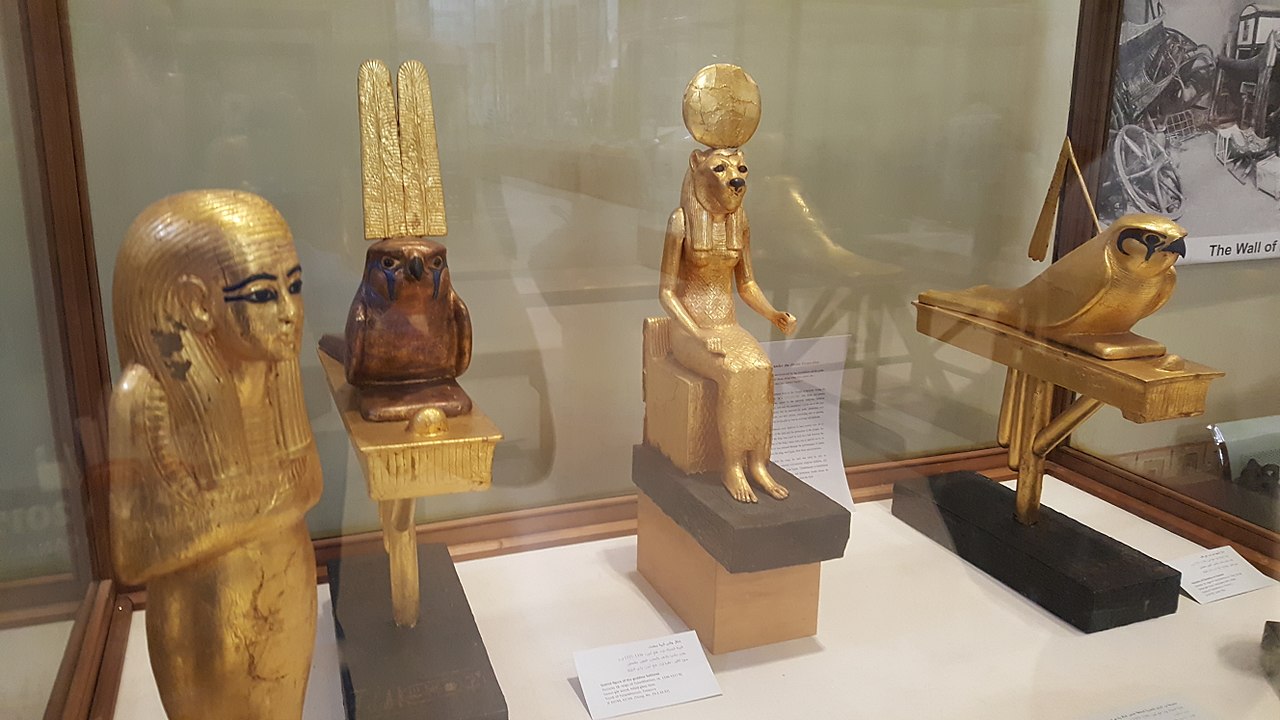 Ovedc, CC BY-SA 4.0, Wikimedia Commons
Ovedc, CC BY-SA 4.0, Wikimedia Commons
The Pharaoh’s Curse: King Tut Becomes Even More Famous
The "curse of the pharaohs," popularly associated with King Tut, refers to the superstition that those who disturbed the tomb of ancient Egyptian pharaohs would suffer misfortune or death.
Is It A Curse Or Coincidence?
While the "curse" was primarily fueled by media sensationalism and public fascination, most scholars and scientists dismiss it as a myth. The deaths of those associated with King Tut's tomb were due to natural causes and infections rather than supernatural forces. But curse or not, King Tut was all the rage.
Tutmania
"Tutmania" refers to the intense global fascination and excitement surrounding the discovery of Tut's tomb, which lasted from the 1920s through the 1930s.
Tutmania: He's Everywhere!
The discovery of King Tut was followed by widespread media coverage, public exhibitions of the tomb's artifacts, and a surge in interest in ancient Egyptian culture. Exhibitions, films, and books about Tutankhamun captured the public's imagination, making him an icon of Egyptian antiquity.
The Excavation Continues
It took about 10 years to excavate Tut’s tomb, from Carter's discovery in 1922 until the completion of the initial excavation and cataloging efforts around 1932. The process involved meticulous work to document and preserve the extensive artifacts found within the tomb.
King Tut's Treasures: The Death Mask
King Tut's death mask is a stunning golden mask adorned with inlaid semi-precious stones. Funerary masks were placed over the faces of mummies to help the spirit recognize the body. Royal funerary masks, like Tutankhamun's, were crafted from gold to resemble the deceased.
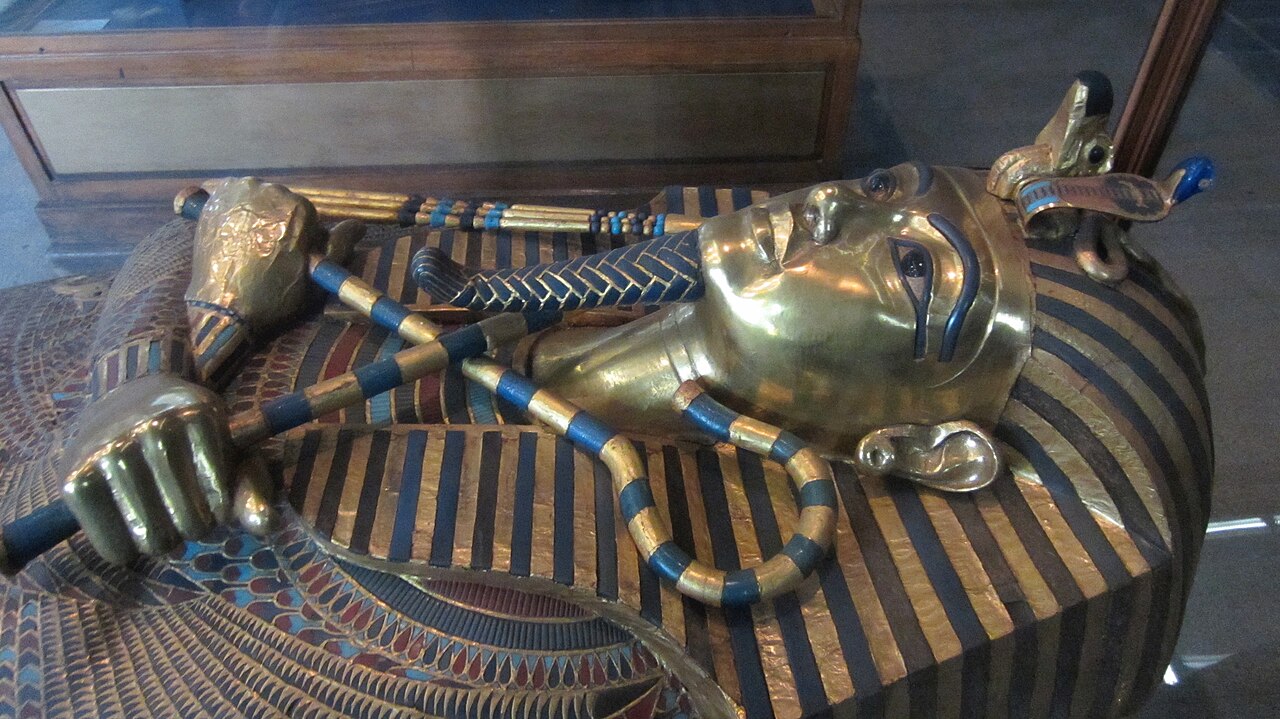 A. Parrot, CC BY-SA 4.0, Wikimedia Commons
A. Parrot, CC BY-SA 4.0, Wikimedia Commons
King Tut's Treasures: The Golden Coffin
Tutankhamun's box-like stone sarcophagus contained three nested coffins to enclose the king's body. King Tut's innermost coffin was solid gold!
 Jahelle, CC BY-SA 4.0, Wikimedia Commons
Jahelle, CC BY-SA 4.0, Wikimedia Commons
King Tut's Treasures: The Golden Sandals
In the crowded antechamber, Carter found a painted wooden box. Inside were King Tut's elaborately decorated golden court sandals, the same ones depicted in some of the figurines discovered in his tomb.
 Al Pavangkanan, CC BY 2.0, Wikimedia Commons
Al Pavangkanan, CC BY 2.0, Wikimedia Commons
King Tut's Treasures: An Iron Dagger
An iron-bladed dagger is not a big deal. What makes this dagger impressive is that King Tut died several centuries before the Iron Age began. And, of course, the handle is all gold.
Stranger yet, when scientists tested the metal, they determined that it came from a meteorite—but it's highly unlikely that the ancient Egyptians would have the technology to craft a weapon from meteorite debris. So, the dagger either came from a more advanced civilization or, as some are convinced, it could have been left behind by aliens.
 Olaf Tausch, Wikimedia Commons
Olaf Tausch, Wikimedia Commons
King Tut's Treasures: Golden Throne
Tutankhamun's golden throne is a unique masterpiece. It is one of the most important and well-preserved pieces of ancient Egyptian furniture.
Its vibrant colors have remained intact for over 3,000 years, showcasing the exceptional skill of the ancient Egyptians.
 Djehouty, CC BY-SA 4.0, Wikimedia Commons
Djehouty, CC BY-SA 4.0, Wikimedia Commons
The Legacy Of King Tut: The Boy King
Tutankhamun's most significant accomplishment was reinstating the worship of Amun-Ra and reverting Egypt to polytheism. Essentially, he put things back in order by revising the religious changes instituted by his predecessor, Akhenaten.
The Legacy Of King Tut: A Snapshot
The historical value of King Tutankhamun's tomb lies mainly in the burial goods, which provided an exceptionally well-preserved snapshot of 18th Dynasty material culture.
The Legacy Of King Tut: Invaluable Insight
The vast artifacts in Tut’s tomb, including the iconic golden mask, chariots, and elaborate jewelry, offered invaluable insights into ancient Egyptian art, craftsmanship, and daily life.
The Legacy Of King Tut: Precious Knowledge
The tomb's intact and rich burial goods allowed scholars to study the ceremonial and everyday items used in the afterlife. These burial items would provide scholars with new details about ancient Egyptian religious practices and royal life that were previously unknown.
 Jean-Pierre Dalbéra, Wikimedia Commons
Jean-Pierre Dalbéra, Wikimedia Commons



